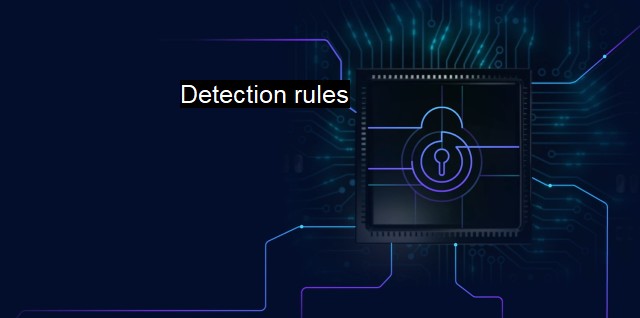What are Detection rules?
How Detection Rules in Antivirus Software Protect Against Cybersecurity Threats
Detection rules, within the context of cybersecurity and antivirus software, constitute an integral layer of our protection systems against threats that lurk in the interactive spheres of the digital world. These rules form the groundwork for processes used in identifying any potential cybersecurity threats, making them an essential asset in mitigating external attacks.Designed as specific criteria or code guidelines, detection rules describe distinct patterns, behavior or attributes associated with harmful software programs or suspicious activities. Such criteria could range from a sequence of bits that match known virus definitions, unusual data transmission volumes, irregularities within system logs, or multiple system access failures.
To grasp the magnitude of its importance, understand that at the core of any antivirus software is an extensive database of detection rules derived from countless malware definitions. A significant proportion of the antivirus functionality is rooted in these detection rules. When scanning your computer or network, the antivirus software segregates each file, breaks down the data structure into clusters or individual bits, and matches the derived data against the configured detection rules in its database. If a data pattern aligns with any of these predefined rules, the antivirus raises an alarm that a threat has been detected.
In contemporary cybersecurity practices, the structure of detection rules expands more than just thread definitions. It also covers rules for the detection of malicious activities and behavior-based anomalies. These are often accustomed to the "baseline" of expected behavior in a system with the intention of noticing deviations. The normalization of certain patterns within network or user behavior constructs this baseline. Any activity or behavior that strays from the baseline implicates a potential security threat, triggering an alert through anomaly detection rules.
The creation and integration of detection rules into security systems aren't one-off tasks. The ever-evolving landscape of cybersecurity threats necessitate perpetual updates to these rules. There's a requirement of regular ‘training’ to equip the system with fresh detection rules in accordance with newly identified malware, vulnerabilities, or exploits. As novel threats emerge and existing ones evolve, seasoned cybersecurity professionals modify and update their detection rules continuously to keep abreast with a constantly transforming threat landscape.
Take sandboxing – a popular advanced feature in modern antivirus. Its effectiveness depends heavily on the training the system has received based on defined detection rules. The sandbox simulates a secure environment and quietly lets the software in question operate within this ‘safe’ scenario. Observation of the software's behavior, whilst considering the baseline expectations, facilitates a logical determination about whether the software is malignant or benign.
Similarly, Intrusion Detection Systems (IDS) is another example of an authoritative implementation of detection rules. A network-based IDS monitors ingress and egress traffic for signs of potential attacks using numerous detection rules crafted for typical attack signatures or abnormal traffic patterns.
Applying and managing detection rules isn't without its cons. One recurring challenge lies in balancing the system’s sensitivity to ensure it doesn't pick up false positives while remaining vigilant to genuine threats. The trade-off between avoiding unnecessary system alerts and maintaining optimum threat detection vigilance often proves a complex act.
Detection rules in cybersecurity form an irreplaceable segment of the modern frontline security architecture. Whether employed in elementary antivirus programs or advanced cybersecurity system, the significance of detection rules in procuring a secure digital framework is indisputable. As the realm of digital threats continues to expand and evolve, so must the parameters of our cybersecurity detection rules, maintaining robust defence walls more than ever.

Detection rules FAQs
What are detection rules in cybersecurity and antivirus software?
Detection rules are sets of instructions or algorithms used by security software to identify and detect known or potential threats to a system. These rules are based on specific patterns or behaviors associated with viruses, malware, and other cyber threats.How do detection rules work in antivirus and cybersecurity software?
Detection rules work by scanning files, programs, and network traffic to look for signs of malicious activity. If the software identifies any suspicious patterns or behaviors that match the rules, it will flag the file or program as a threat and take appropriate action to contain or remove it.How are detection rules created and updated in cybersecurity and antivirus software?
Detection rules are developed by security researchers and analysts who study the latest trends and techniques used by cybercriminals. They use this information to create new rules and update existing ones to ensure that the software can effectively detect and block new threats as they emerge.Can detection rules be bypassed by cybercriminals?
While detection rules are an important part of cybersecurity and antivirus software, they are not foolproof. Sophisticated cyber threats may be designed to evade detection by using new techniques or by exploiting vulnerabilities in the software itself. However, regular updates and improvements to detection rules can help to minimize the risk of successful attacks.| | A | | | B | | | C | | | D | | | E | | | F | | | G | | | H | | | I | | | J | | | K | | | L | | | M | |
| | N | | | O | | | P | | | Q | | | R | | | S | | | T | | | U | | | V | | | W | | | X | | | Y | | | Z | |
| | 1 | | | 2 | | | 3 | | | 4 | | | 7 | | | 8 | | |||||||